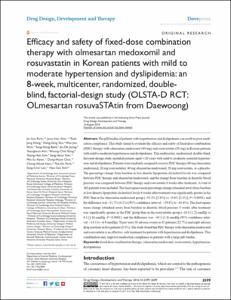KUMEL Repository
1. Journal Papers (연구논문)
1. School of Medicine (의과대학)
Dept. of Internal Medicine (내과학)
Efficacy and safety of fixed-dose combination therapy with olmesartan medoxomil and rosuvastatin in Korean patients with mild to moderate hypertension and dyslipidemia: an 8-week, multicenter, randomized, double-blind, factorial-design study (OLSTA-D RCT: OLmesartan rosuvaSTAtin from Daewoong)
- Affiliated Author(s)
- 남창욱
- Alternative Author(s)
- Nam, Chang Wook
- Journal Title
- Drug Design, Development and Therapy
- ISSN
- 1177-8881
- Issued Date
- 2016
- Keyword
- fixed-dose combination therapy; olmesartan medoxomil; rosuvastatin; hypertension; dyslipidemia
- Abstract
- The pill burden of patients with hypertension and dyslipidemia can result in poor medication compliance. This study aimed to evaluate the efficacy and safety of fixed-dose combination (FDC) therapy with olmesartan medoxomil (40 mg) and rosuvastatin (20 mg) in Korean patients with mild to moderate hypertension and dyslipidemia. This multicenter, randomized, double-blind, factorial-design study included patients aged ≥20 years with mild to moderate essential hypertension and dyslipidemia. Patients were randomly assigned to receive FDC therapy (40 mg olmesartan medoxomil, 20 mg rosuvastatin), 40 mg olmesartan medoxomil, 20 mg rosuvastatin, or a placebo. The percentage change from baseline in low-density lipoprotein cholesterol levels was compared between FDC therapy and olmesartan medoxomil, and the change from baseline in diastolic blood pressure was compared between FDC therapy and rosuvastatin 8 weeks after treatment. A total of 162 patients were included. The least square mean percentage change (standard error) from baseline in low-density lipoprotein cholesterol levels 8 weeks after treatment was significantly greater in the FDC than in the olmesartan medoxomil group (−52.3% [2.8%] vs −0.6% [3.5%], P<0.0001), and the difference was −51.7% (4.1%) (95% confidence interval: −59.8% to −43.6%). The least square mean change (standard error) from baseline in diastolic blood pressure 8 weeks after treatment was significantly greater in the FDC group than in the rosuvastatin group (−10.4 [1.2] mmHg vs 0.1 [1.6] mmHg, P<0.0001), and the difference was −10.5 (1.8) mmHg (95% confidence interval: −14.1 to −6.9 mmHg). There were 50 adverse events in 41 patients (22.7%) and eight adverse drug reactions in five patients (2.8%). The study found that FDC therapy with olmesartan medoxomil and rosuvastatin is an effective, safe treatment for patients with hypertension and dyslipidemia. This combination may improve medication compliance in patients with a large pill burden.
- Department
- Dept. of Internal Medicine (내과학)
- Publisher
- School of Medicine
- Citation
- Jin-Sun Park et al. (2016). Efficacy and safety of fixed-dose combination therapy with olmesartan medoxomil and rosuvastatin in Korean patients with mild to moderate hypertension and dyslipidemia: an 8-week, multicenter, randomized, double-blind, factorial-design study (OLSTA-D RCT: OLmesartan rosuvaSTAtin from Daewoong). Drug Design, Development and Therapy, 10, 2599–2609. doi: 10.2147/DDDT.S112873
- Type
- Article
- ISSN
- 1177-8881
- Appears in Collections:
- 1. School of Medicine (의과대학) > Dept. of Internal Medicine (내과학)
- 파일 목록
-
-
Download
 oak-2017-0103.pdf
기타 데이터 / 514.21 kB / Adobe PDF
oak-2017-0103.pdf
기타 데이터 / 514.21 kB / Adobe PDF
-
Items in Repository are protected by copyright, with all rights reserved, unless otherwise indicated.